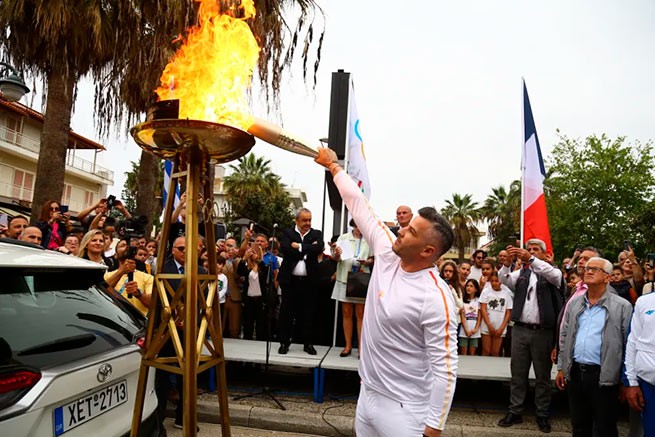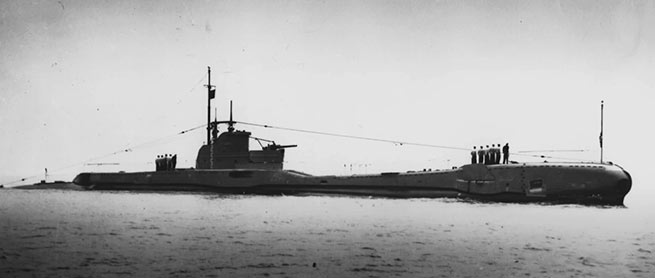The British submarine HMS Triumph, whose true fate has been shrouded in mystery ever since the ship and her entire crew disappeared in 1942, has finally been discovered at the bottom of the Aegean Sea by Greek explorer Kostas Toktaridis and his crew.
The search lasted for about 25 years
The submarine disappeared without a trace with all 64 crew members about 81 years ago, at the height of World War II. Various attempts to find it were made at different times by teams from the UK, Malta and Russia, but without success.
Finally, Toktaridis and his team managed to unravel the mystery of her disappearance after a search that first began in 1998. “It was the most difficult and most expensive mission I have ever undertaken in my life,” Toktaridis told the state news agency. amna.
“The story of the submarine is multifaceted and unique in the naval chronicles, as it is inextricably linked with the national resistance and the intelligence services of the time, operating during the occupation,” he added. According to him, the key to unraveling the mystery, which has remained hidden for more than eight decades, is “research using primary sources. It was necessary to conduct an extensive study of archives both in Great Britain and in Germany, as well as in Italy and Greece.
“HMS Triumph” in the waters of the Aegean Sea
First launched in 1938,triumph» seriously entered the Second World War in May 1939 and completed a total of 20 combat exits. He first entered the Aegean Sea at the end of March 1941 to reconnoiter the shores of the Dodecanese Islands and land officers on the Greek shores.
He achieved some success, sinking a large number of enemy ships, including the Italian submarine Salpa. She also flew difficult missions to drop Special Operations Executives (SOEs) and MI9 agents and rescue soldiers trapped during the British retreat who needed to flee to Alexandria in Egypt.
On 26 December 1941 Triumph sailed from Alexandria for her 21st and final mission before returning to England for overhaul and maintenance. He was ordered to conduct two special operations, and in the meantime patrol a certain section of the Aegean Sea.
On board the vessel were very unusual crew members – SOE and MI9 agent Lieutenant George Atkinson, SOE Greek wireless communications expert Diamantes Arvanitopoulos (codename DIAMOND), New Zealand communications officer Captain Craig, two British Army commandos from the Northamptonshire Regiment and the Royal Regiment, as well as artillery and five tons of emergency equipment. Atkinson’s (codename ISINGLASS) mission was to rendezvous with a Greek resistance cell in Athens and then free 18 select Allied soldiers who had been taken prisoner by the Italians.
Atkinson carried a significant amount of money in cash and gold coins, intended to help MI9 and SOE to specific individuals in occupied Athens, as well as two sets of radio transmitters to communicate with Cairo.
Captain Craig led the second secret mission, codenamed “Coney Island”, which was to coordinate the release of 30 British fugitives who were on the island. Antiparos.
In his pocket, Atkinson had his operational protocol typewritten with the heading (‘NOT TO BE TAKEN ASHORE’). Since his mission was complicated by double instructions from SOE and MI9, he had to ignore this warning.
On the night of December 29-30, 1941, the Triumph entered the bay Despotico, where he landed a special forces group and left supplies for them. Captain John S. Haddart informed 30 commandos that he had orders to patrol the Aegean and would return to pick them up on January 9-10 for Alexandria. He also announced by radio the successful completion of the first phase of the mission. This was the last message received from the ship.
All members of the SOE team were arrested at Antiparos and the Atkinson operation document, which listed the names of 37 members of the Greek resistance in Athens with their pseudonyms and code numbers, fell into the hands of the enemy.
The information was passed on to the German authorities and all 37 were captured and executed along with Atkinson. The rest were sent to concentration camps.
Last attack south of Sounio
“triumph“continued patrolling, making itself felt near the islands of Milos and Naxos. On January 9, 1942, at 11:45 am, he attacked the Rhea cement ship towed by the Taxiarchis south of Sounion, while the torpedo missed and exploded on the coastal rocks. “We recently identified three more British Mk VIII torpedoes in the same part of the depths of the same type that was used”triumph“, Toktaridis said. The submarine was last seen in motion by an Italian pilot flying in the area, about four nautical miles southeast of Sounion, he added, noting that this previously lost piece of information helped solve the “mystery” of the submarine’s history.
After that, all traces of the ship disappear and on January 23, 1942, the British Admiralty declared that the submarine must be considered lost.
Opening of HMS Triumph
The missing submarine is found 81 years later by Toktaridis and his team, who described it as “awe-inspiring underwater grave for 64 heroes”. It lies on the seabed under water, with a list of eight degrees to starboard, tens of kilometers from the coast.
The periscopes and hatches are lowered, indicating that she was in a deep dive in her last moments, while the depth and rudders indicate that she was moving at a constant depth.
The turret carries a wooden steering wheel, a compass, and a slightly raised four-inch cannon. The hatches on both sides of the gun leading inside are also closed. On the forward side of the bridge, the door leading to the artillery room is open … all hatches are closed. The right torpedo tube opened, the MK VIII torpedo was half out of the submarine.
Apparently, the submarine sank due to a powerful explosion in the bow, but the cause of the explosion is still unclear.
“Our research continues, mainly at the historical level, as new evidence and facts emerge. Combined with the information we now have from the crash site and with the help of naval experts specializing in submarines and torpedoes, they will unlock the secrets of HMS Triumph,” Toktaridis said.







More Stories
Olympic torch relay: traffic restrictions in Athens and Attica on Friday
Ancient papyrus reveals Plato's burial site
Metropolitan Chrysostom: "The Church will never recognize same-sex marriage – the issue is not closed"